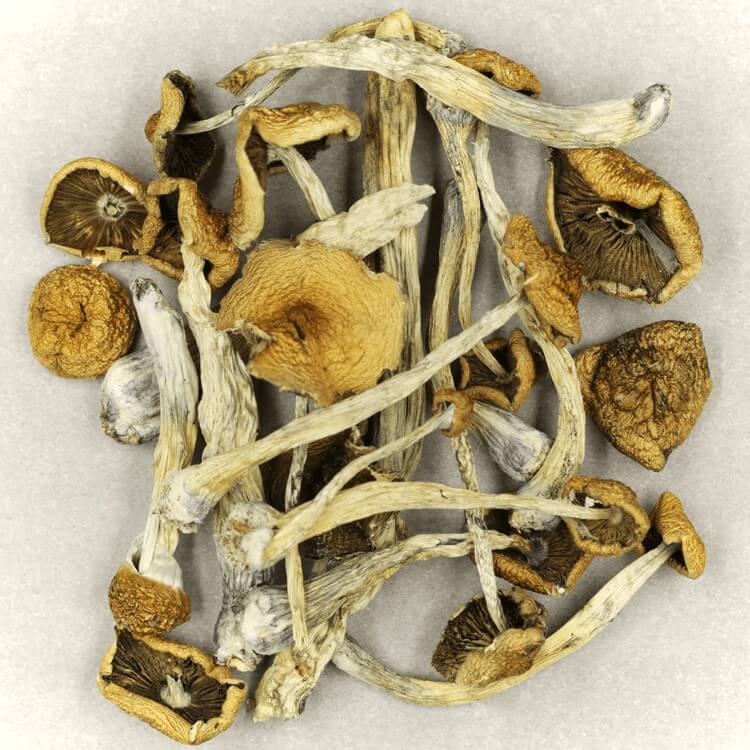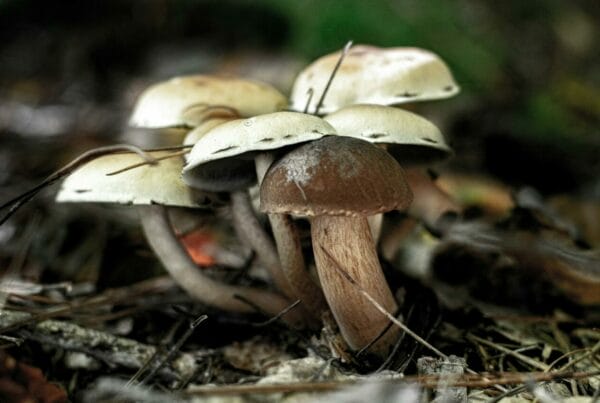Once viewed as merely a potent hallucinogen, the Psilocybe mexicana has seen a shift in perception, thanks to ongoing psilocybin research. The psychedelic research community consistently uncovers its therapeutic potential, gradually earning it a place in the medical field. This burgeoning area of study shows promise, as experts tirelessly work to establish safe dosage levels for medical purposes.
Key Takeaways
- Researchers are utilizing innovative techniques such as liquid chromatography coupled with tandem mass spectrometry to ascertain the potency of mushrooms.
- Clinical trials are underway to explore the potential therapeutic applications of Psilocybe Mexicana and other mushroom varieties.
- The genetic diversity in magic mushrooms plays a crucial role in formulating an accurate dosage chart.
Psychedelic Mushrooms: Journey from Obscurity to Research Milestones
Earlier, only a few conditions were thought to benefit from Psilocybe Cubensis. However, current research on psilocybin is revealing an array of hidden medicinal properties.
Researchers are harnessing the potential of Psilocybe Mexicana and other potent strains for in-depth studies and clinical trials. Whether the research is in vivo or in vitro, this strain consistently demonstrates the most authentic effects and benefits of the mushroom species.
Psychedelics Making Their Way into the Market
What was once shrouded in mystery is now coming to light – continuous breakthroughs and discoveries are piquing public interest, especially for those seeking effective therapeutic solutions. Traditional mental health treatments often prove inadequate, leading individuals to explore more reliable alternatives.
The solution? Magic mushrooms.
People struggling with mental health conditions are turning to psilocybin, which has shown potential in treating depression, alcohol dependency, anxiety, compulsions, tics, chronic pain, and more.
Currently, medical professionals are investigating cutting-edge methods to determine the ideal dosage for safe patient administration. Notably, a group of researchers from the University of Texas has crafted a model to measure psilocybin and psilocin concentrations.
Clinically determining the potency of magic mushrooms is now within reach.
The Distinctive Attributes of Mexicana
Golden Teachers, Blue Meanies, and B-Plus are varieties of magic mushrooms that have been thoroughly researched. However, for a comprehensive understanding of the safe use of magic mushrooms, it’s critical that scientists broaden their scope to other species.
The Mexicana variety has gained popularity in research circles, not just because it’s one of the oldest known species, but also because its relatively moderate potency aligns better with medical drug standards.
Even though the potency of this Mexican variety is less pronounced compared to others, it can still yield effects akin to those of more mainstream strains. As the practice of microdosing gains traction among users, this variety becomes an increasingly attractive option.
The Mexicana has consistent levels of psilocybin and psilocin, akin to other strains. So, what makes it stand out from its counterparts? The answer lies in its historical and anthropological significance.
Delving into a Fascinating “Mexican” Legacy
In antiquity, Psilocybe Mexicana naturally thrived in moss. These psilocybin mushrooms were held in high regard by indigenous populations, often associated with mystical or supernatural occurrences.
Now, let’s shift our focus to Mexican mushrooms. The first documented use of these mushrooms dates back over 2000 years by the natives of North and Central America. The Aztecs, an ancient civilization, dubbed these mushrooms as the “food of the Gods,” or “teonanácatl” in their native tongue.
If the Aztecs were present today, they would attest to the transformative, emotionally potent, and mentally stabilizing effects of the Mexicana—even without comprehending these contemporary terminologies.
Despite varied cultivation techniques, this mushroom species has retained its natural psilocybin concentrations, underscoring its authenticity. This genuineness is a widely recognized standard that both researchers and psychedelic research institutions immensely value.
Innovative Strategies for Testing Psilocybin Content and Potency
A team of ten researchers, hailing from the University of Texas at Arlington and other research institutions, has devised a novel method to test the potency of psychoactive compounds in mushrooms. This new measurement approach integrates liquid chromatography and tandem mass spectrometry.
Here are two groundbreaking techniques:
- Liquid chromatography is a technique used to separate and analyze chemical mixtures. It is particularly utilized in the analysis of active chemicals in mushrooms. The procedure requires a liquid sample to be passed through a column filled with a stationary phase, a solid material. As the chemicals in the sample interact differently with both the stationary phase and the mobile phase, they separate at varying rates while moving through the column.
- Spectrometry is a study focused on the interaction between matter and electromagnetic radiation across different wavelengths. It identifies and quantifies substances based on the distinct wavelengths of light that the molecules both absorb and scatter. This assists in determining the electronic, vibrational, and rotational states of a particular chemical.
Five strains of magic mushrooms were analysed using this technique. The research found that the average total levels of psilocybin and psilocin across these strains varied between 0.879 to 1.36. These concentrations exceeded numerous other varieties, like Bull Run and Cambodian. The accuracy of their study was confirmed by comparing their findings with results from other independent laboratories.
The congruence of results between the two labs further reinforced the accuracy of their testing method in determining the potency of the mushrooms.
If these findings are confirmed by experts, it could lead to the development of new methods of strength testing for psychedelics, acting as an extra precautionary measure to avoid unsafe dosage determinations.
Expanding Research to Additional Species
Extending the research to encompass other species could prove beneficial. It could deepen our understanding of the health benefits associated with different strains and provide crucial data on the effects of less potent mushrooms.
Moreover, it could assist in educating individuals about the influence of different dosages on the psychedelic experience. By comparing Mexicans with stronger strains like Psilocybe Cubensis, researchers could establish how different concentrations of active compounds could impact therapeutic results.
For example, the Blue Meanies strain induces stronger hallucinogenic effects, which might be effective in treating conditions such as depression. On the other hand, strains with lower potency are more suitable for microdosing or for subtler applications like mood enhancement or focus improvement.
Diverse Genetics Lead to Safer Treatments
It’s less commonly known that different cultivars or varieties have distinct genetic profiles and
There is a broad range in the strength, composition, and effects of hallucinogenic mushrooms. This diversity allows healthcare professionals to select the most suitable type for particular medical applications, and to adjust doses to meet individual requirements, thereby reducing risks and maximising benefits.
Take, for instance, Psilocybe Semilanceata (Liberty Caps) or Psilocybe cyanescens. These mushrooms have distinctive alkaloid profiles that may be effective in treating anxiety. On the other hand, other artificially grown mushrooms may be more appropriate for addressing substance misuse or compulsions. This diversity supports the development of personalised treatments with enhanced safety and effectiveness.
From this, we can infer that the genetic diversity in hallucinogenic mushrooms, combined with new methods for evaluating strength and identifying strains, is vital for formulating safer medical treatments.
Enhanced Safety in Medical Use
Let’s take a moment to contemplate the potential benefits of safer dosing.
- Lowered risk of overdosing: With accurate dosing, users can be free from the worry of overdosing. This also means that product labels should be clearer to avoid causing confusion among consumers.
- Increased predictability: With more precise dosing, individuals can better anticipate the effects or experiences they may encounter during their trips. This could reduce intense sensations and anxiety, leading to greater patient satisfaction.
- Standardised measurement: In some way, accurate dosing could lead to a standardised metric, enabling people to easily refer to charts for potential effects.
Experience the Benefits of Precisely-dosed Mushrooms through Advanced Potency Tests | Buy Magic Mushrooms Online at Magic Mushrooms Edmonton Canada
If these two innovative techniques continue to be used, you will no longer have to deal with unforeseen effects. Pair this with smart online shopping at Magic Mushrooms Edmonton Canada, where we offer dried mushrooms that provide a calm, relaxing psychedelic experience without excessive psychoactivity. Buy psychedelics online in Canada through Magic Mushrooms Edmonton Canada.
Frequently Asked Questions
Is Psilocybe Mexicana similar to Big Mexicans?
Are Big Mexicans and Psilocybe Cubensis the same?
No, Big Mexicans and Psilocybe Cubensis are distinct strains of mushrooms, so it’s crucial not to confuse them. Big Mexicans have a higher level of compound isolation, ranging from 0.5% to 1%, making them significantly more potent
Psilocybe Zapotecorum and Psilocybe Cubensis differ not only in potency but also in appearance. The former typically possesses a bell-shaped cap, while the latter is frequently conical in shape.
What is the highest concentration achievable in Mexican mushrooms?
The concentrations of psilocybin and psilocin in Mexican mushrooms can potentially reach up to 0.25%. Though these levels are relatively low and comparable to the Golden Teacher strain, they can still induce strong psychedelic experiences, which may have potential health benefits.
What dosage is considered safe for medical use?
Typically, a dosage between 1 to 2 grams is recommended. However, this dosage can vary depending on factors such as the method of consumption, an individual’s metabolism, and the specific potency of the mushroom strain. Some individuals opt for sub-threshold doses ranging from 0.05 (50mg) to 0.025 grams (250mg) to minimize the psychedelic effects.





